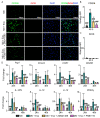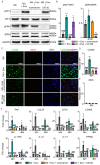Mesenchymal Stromal Cell Exosomes Mediate M2-like Macrophage Polarization through CD73/Ecto-5'-Nucleotidase Activity
- PMID: 37242732
- PMCID: PMC10220822
- DOI: 10.3390/pharmaceutics15051489
Mesenchymal Stromal Cell Exosomes Mediate M2-like Macrophage Polarization through CD73/Ecto-5'-Nucleotidase Activity
Abstract
Mesenchymal stem/stromal cell (MSC) exosomes have been shown to alleviate immune dysfunction and inflammation in preclinical animal models. This therapeutic effect is attributed, in part, to their ability to promote the polarization of anti-inflammatory M2-like macrophages. One polarization mechanism has been shown to involve the activation of the MyD88-mediated toll-like receptor (TLR) signaling pathway by the presence of extra domain A-fibronectin (EDA-FN) within the MSC exosomes. Here, we uncovered an additional mechanism where MSC exosomes mediate M2-like macrophage polarization through exosomal CD73 activity. Specifically, we observed that polarization of M2-like macrophages by MSC exosomes was abolished in the presence of inhibitors of CD73 activity, adenosine receptors A2A and A2B, and AKT/ERK phosphorylation. These findings suggest that MSC exosomes promote M2-like macrophage polarization by catalyzing the production of adenosine, which then binds to adenosine receptors A2A and A2B to activate AKT/ERK-dependent signaling pathways. Thus, CD73 represents an additional critical attribute of MSC exosomes in mediating M2-like macrophage polarization. These findings have implications for predicting the immunomodulatory potency of MSC exosome preparations.
Keywords: CD73; exosomes; extracellular vesicles; immunomodulation; macrophage; mesenchymal stromal/stem cells.
Conflict of interest statement
The authors report that they have no conflict of interest in this study. S.K.L. holds founder shares in Paracrine Therapeutics Pte Ltd.
Figures







References
Grants and funding
LinkOut - more resources
Full Text Sources
Research Materials
Miscellaneous

